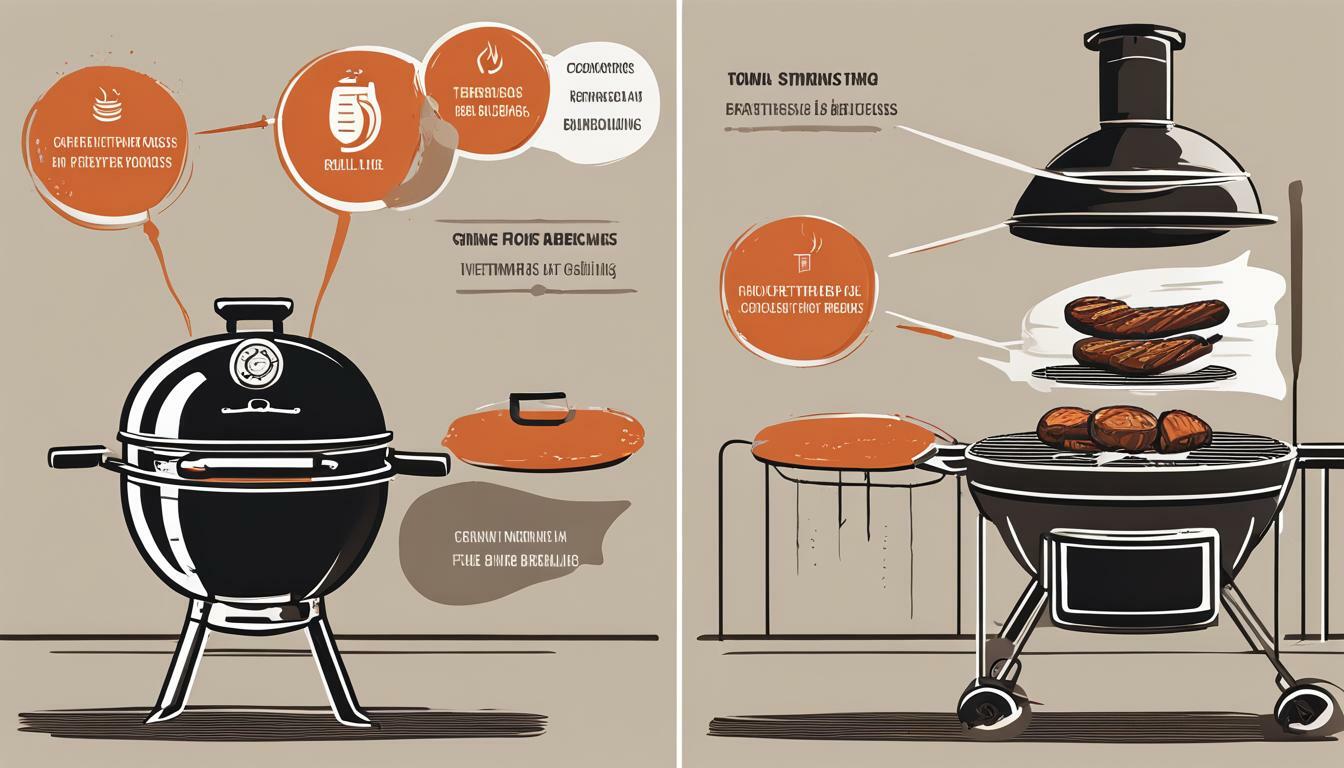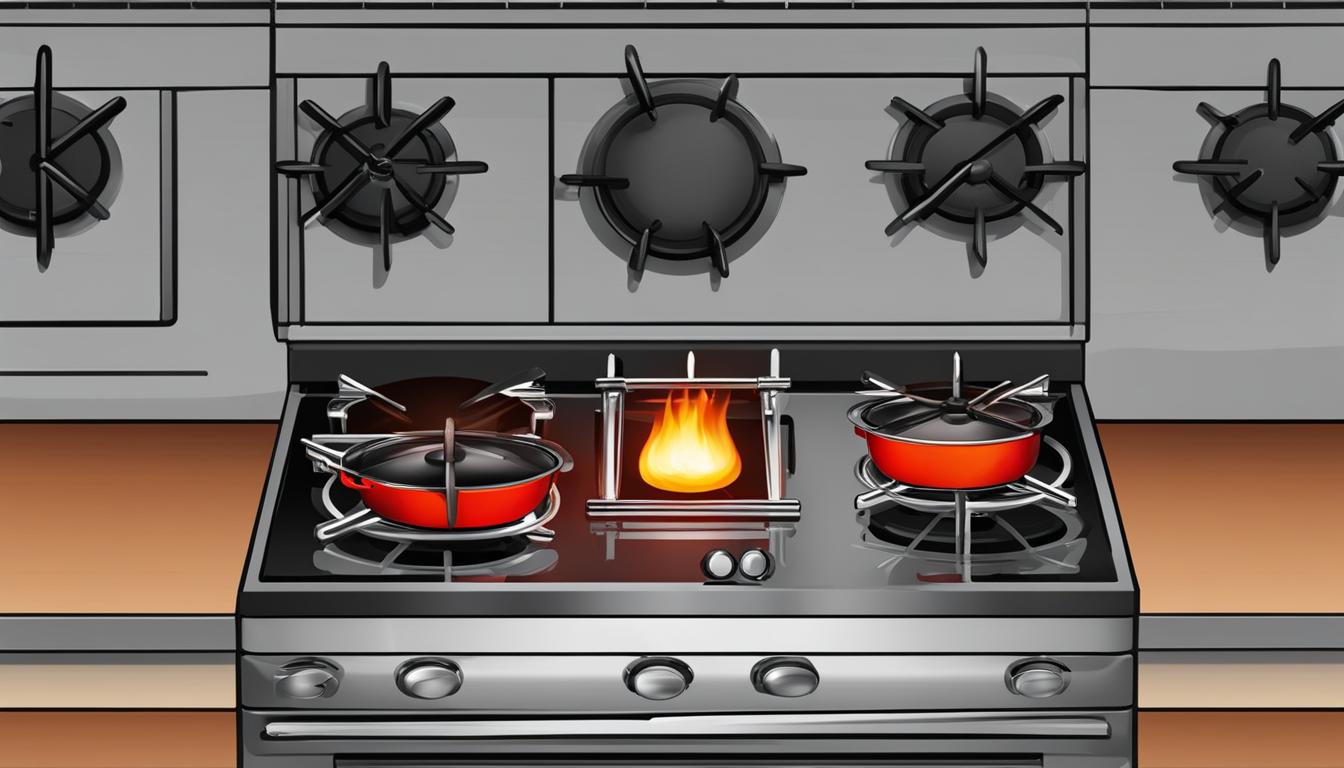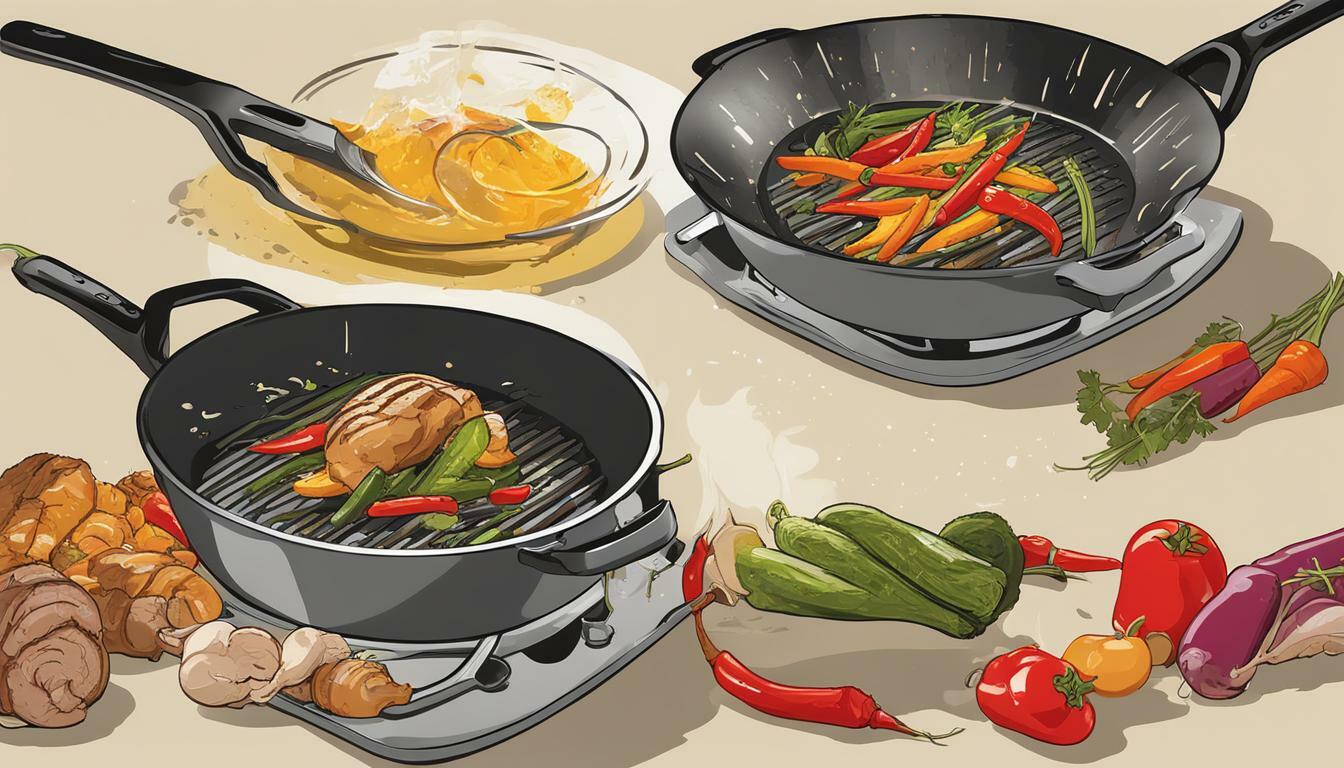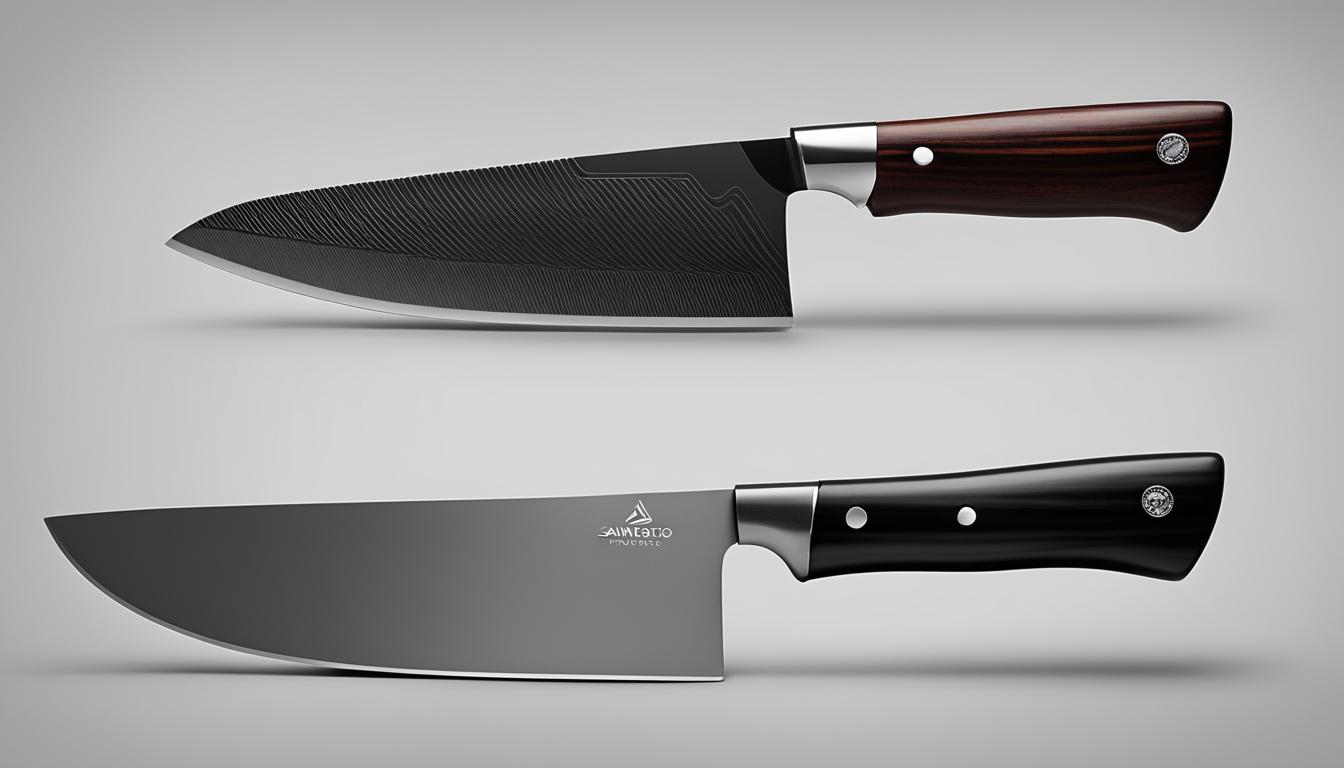Grilling and barbecuing are two popular cooking methods that many people often use interchangeably. However, there are distinct differences between the two methods. While both use heat to cook food, they have different techniques, cooking durations, and flavors.
In this section, we’ll explore the unique characteristics of grilling and barbecuing, highlighting the differences in their cooking methods. We’ll explore the distinct flavors each method imparts and the tools and equipment required for each. By the end of this section, you’ll have a clear understanding of how grilling differs from barbecuing.
Key Takeaways
- Grilling and barbecuing are two different cooking methods
- They have distinct techniques, cooking durations, and flavors
- Grilling imparts a smoky and charred taste, while barbecuing delivers a rich, slow-cooked flavor
- Grilling requires direct heat, while barbecuing uses indirect heat
- Grilling is generally quicker than barbecuing and is suitable for smaller cuts of meat
Grilling vs. Barbecuing: Techniques and Equipment
Grilling and barbecuing may seem similar but they differ in many ways. One of the most significant differences lies in the technique and equipment used in each method.
Grilling Techniques and Equipment
Grilling involves cooking food directly over high heat, usually from a gas or charcoal flame. The direct heat quickly sears the food, creating a crispy exterior while leaving the interior moist and juicy. Grilling is suitable for cooking smaller cuts of meat, such as steaks, hamburgers, and hot dogs.
Grilling requires minimal equipment, making it a convenient cooking method for outdoor gatherings or spontaneous weeknight dinners. Typical grilling equipment includes a grill, tongs, a spatula, and a meat thermometer. Grills come in various shapes and sizes, including gas, charcoal, and electric models.
Barbecuing Techniques and Equipment
Barbecuing involves cooking food over low, indirect heat, typically from burning wood or charcoal. The slow cooking allows for the meat to become tender and flavorful, as the smoke from the wood or charcoal infuses into the meat. Barbecuing is ideal for larger cuts of meat, such as ribs, briskets, and pork shoulders.
Barbecuing requires specific equipment, which varies depending on the type of barbecue used. Common barbecue equipment includes a smoker, wood or charcoal, and a meat thermometer. Smokers come in various shapes and sizes, from simple barrel models to elaborate custom-built units.
In summary, grilling and barbecuing differ in their techniques and equipment. Grilling involves cooking food directly over high heat, while barbecuing involves slow cooking over low, indirect heat. Both methods have their own unique characteristics and are great for different types of food.
Flavor Profiles: Grilling and Barbecuing
One of the most significant differences between grilling and barbecuing is the flavor profile each method offers. Grilling imparts a smoky and charred taste to foods, while barbecuing delivers a rich, slow-cooked flavor. The type of fuel used, such as wood or charcoal, can also influence the flavors created.
Grilling is known for its ability to create a delicious sear and crispy exterior on foods, such as steaks and vegetables. The high heat of grilling caramelizes the natural sugars in the food, resulting in a sweet and savory flavor. The use of marinades and rubs can also add depth to the grilled flavors.
On the other hand, barbecuing involves cooking food at a lower temperature for a longer period of time, allowing the meat to slowly break down and become tender. The smoke from the wood or charcoal adds a unique flavor to the food, resulting in a rich and complex taste. Barbecuing is often used for tougher cuts of meat, such as brisket and ribs, to make them more tender and flavorful.
Cooking Duration: Grilling vs. Barbecuing
One of the most significant differences between grilling and barbecuing is the cooking duration. In general, grilling is a quicker method of cooking than barbecuing, and it is suited for smaller cuts of meat that can be cooked in a shorter amount of time.
Grilling usually requires a cooking duration ranging from a few minutes to 15 minutes, depending on the thickness and doneness of the meat. This makes it ideal for steaks, burgers, hot dogs, and other small cuts that can be cooked to perfection with high heat and direct flames.
Barbecuing, on the other hand, is a slow cooking method that can take several hours to complete. The extended cooking duration is necessary to break down the tough connective tissues in larger cuts of meat, making them more tender and flavorful. A typical barbecuing duration ranges from three to six hours, and sometimes even longer.
Overall, while grilling is a quick and efficient cooking method, barbecuing requires patience and time to achieve the perfect result. The choice between the two comes down to your personal preferences and the type of meat you want to cook.
Versatility: Grilling and Barbecuing
One of the great things about both grilling and barbecuing is their versatility in cooking various foods.
Grilling is perfect for quick, high-heat cooking of items like burgers, hot dogs, steaks, vegetables, and even fruits. The direct heat from the flames sears the food and locks in the juices, resulting in delicious and tender dishes.
On the other hand, barbecuing allows for slow cooking and smoking of items like brisket, ribs, pork shoulder, and even whole chickens or turkeys. The indirect heat and smoke add depth to the flavors and make tougher cuts of meat more tender.
Both methods also provide opportunities for experimentation with different fuels, rubs, marinades, and sauces.
Difference Between Caramelizing and Sautéing
While both caramelizing and sautéing involve cooking food using heat, they are distinct techniques with different applications in the kitchen.
Caramelizing is a cooking process that involves heating sugar until it melts and turns brown, creating a rich, sweet flavor. This technique is often used in desserts, sauces, and glazes to add depth and sweetness to dishes. Caramelizing can also be used with vegetables, such as onions, to create a caramelized flavor that’s perfect for adding to soups and stews.
Sautéing, on the other hand, is a cooking technique that involves quickly cooking food in a small amount of fat over high heat. Sautéing is great for preparing vegetables, meats, and seafood, as it allows for quick cooking while maintaining texture and flavor.
The main difference between caramelizing and sautéing is the cooking process and the end result. While caramelizing creates a sweet, browned flavor, sautéing creates a flavorful and crispy texture.
It’s important to note that these techniques can be complementary in certain dishes. For example, caramelizing onions before sautéing them can create a deep, sweet flavor that pairs well with meats and vegetables.
Caramelizing: Technique and Process
Caramelizing is a culinary technique that involves heating sugar until it melts and turns into a rich, brown liquid. This process can add a sweet and distinct flavor to many different types of dishes, including desserts, sauces, and vegetables.
The caramelizing technique is relatively simple and involves heating sugar over medium-high heat until it melts and turns amber in color. It’s important to stir the sugar frequently to ensure it melts evenly and does not burn. Once the sugar is melted, it can be used immediately or combined with other ingredients to create a variety of dishes.
There are different methods for caramelizing sugar, including dry caramelizing and wet caramelizing. In dry caramelizing, the sugar is heated without any added liquids, resulting in a more intense and complex flavor. Wet caramelizing involves adding a small amount of water to the sugar, which can help prevent it from burning and create a smoother texture.
When caramelizing sugar, it’s essential to use a heavy-bottomed pan to ensure even heat distribution and prevent burning. It’s also important to be patient since the process can take several minutes, and the sugar can go from melted to burnt quickly.
In summary, caramelizing is a useful technique that adds a rich, sweet flavor to many different types of dishes. With the right tools, patience, and practice, anyone can learn how to successfully caramelize sugar and elevate their cooking skills.
Sautéing: Technique and Process
Sautéing is a quick and simple cooking method that involves cooking food in a small amount of fat over medium to high heat. This technique is often used for vegetables, meat, and seafood, creating a flavorful and crispy texture. Here’s an overview of the sautéing technique and process:
Sautéing Technique
The key to successful sautéing is to use a heavy-bottomed pan that heats evenly. Start by heating a small amount of oil or butter in the pan over medium to high heat until hot but not smoking. Swirl the oil to cover the bottom of the pan evenly.
Add your food to the pan, making sure not to overcrowd it. This will ensure that the food cooks evenly and develops a crispy texture. Toss or stir the food occasionally to prevent it from sticking to the pan.
For added flavor, you can also add aromatics like garlic, onions, or herbs to the pan while sautéing.
Sautéing Process
When sautéing meat or seafood, it’s important to let it brown on one side before flipping it over to cook the other side. This will help to develop a flavorful crust and prevent the meat from sticking to the pan.
For vegetables, sauté them until they are tender-crisp and lightly browned. Overcooking can result in a mushy texture and loss of nutrients.
Once your food is cooked to your desired doneness, remove it from the pan and serve immediately.
By mastering the sautéing technique and process, you can elevate your cooking skills and create delicious meals in no time!
Conclusion
Grilling and barbecuing are two popular cooking methods that offer distinct flavors and techniques. Grilling involves high heat and direct cooking, resulting in a smoky and charred taste, while barbecuing involves slow cooking with indirect heat, producing a rich and slow-cooked flavor.
They both offer versatility in cooking, with grilling allowing for quick, high-heat cooking of various foods, and barbecuing allowing for slow cooking and smoking, adding depth to flavors. Understanding the differences between these methods and their unique characteristics can help you decide which one to use depending on the type of meat and flavor profile you want to achieve.
Caramelizing and Sautéing
In addition to discussing grilling and barbecuing, we also explored the differences between caramelizing and sautéing. While caramelizing involves cooking sugar until it melts and turns brown, imparting a rich, sweet flavor to various dishes, sautéing involves quickly cooking food in a small amount of fat over high heat, resulting in a flavorful and crispy texture.
Both techniques have their unique applications in cooking, and understanding how to properly execute them can vastly improve the flavor and texture of your dishes.
Overall, cooking is an art that involves different techniques, tools, and methods. By understanding the differences between grilling and barbecuing, as well as caramelizing and sautéing, you can elevate your cooking game and impress your friends and family with delicious and flavorful dishes.
 Skip to main content
Skip to main content


